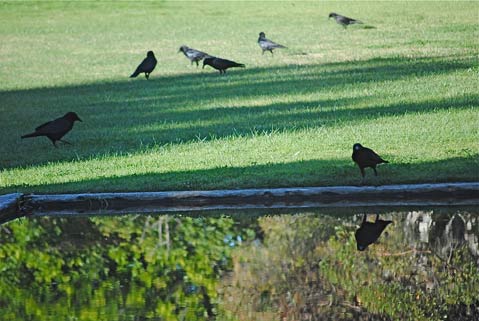Crows Smarter than Humans Think
An Opportunist, the Big Bird Intrigues and Annoys

It is not the largest bird in the sky; neither does it have the sharpest beak nor strongest claws. But an air of formidability wraps the adult American crow, especially when individuals flock to forage sites as they did locally during the recent rains.
This was my main impression as I watched around 30 crows space themselves near one end of an El Encanto Heights open space and slowly walk through a light rain, plucking worms from the grass. They hunted in purposeful silence, cocking heads to one side to scan for targets; then snatching worms that had washed out of the soil.

Through a filter of gray clouds, the light cloaked their black feathers in an iridescent purple-blue sheen. Combined with a stiff gait, the birds closest to my window took on an eerie, mechanical appearance—and endowed the scene with a sense of menace.
Okay, I borrowed the “menace” from Hitchcock’s 1963 nature-in-rebellion film The Birds. There was no threat from the birds in the open space, despite a long literary and folk tradition associating crows with evil.
A flock of these clever, social birds is even called a “murder of crows,” though other birds and animals are better equipped to inflict damage. The crow’s thick bill cannot penetrate the skin of small mammals, like squirrels, according to experts at the Cornell Lab of Ornithology , which is why this bird often scavenges road kill.
Crows are known for their opportunistic diet. They will eat most grains, seeds, nuts, berries, and fruits as well as earthworms, insects, smaller birds, and the unguarded eggs of other birds. If they live near a seashore they may go after small fish, mussels, or clams. If an uncovered landfill—or trashcan—is handy you might find them picking through your garbage, if the gulls haven’t gotten to it first.
With a wingspan of about three feet and a body length ranging from 15 to 21 inches, the big, black adults are notable. “They are highly visible to the average person,” agrees veteran bird watcher and counter Joan Lentz. She leads the annual Santa Barbara Audubon Society Christmas Bird Count, which usually places American crows among the most frequently counted species in the county.
Though the local field count will be over by print time, Lentz reported that searching the previous 10 years’ results revealed that 2008-09 had the highest sightings, with more than 2,600 crows; other years had less than 40 percent of that number. Rain storms and the West Nile virus, which was especially lethal to crows, influenced annual fluctuations.
While Goleta still claims patches of wildlife habitat and some farmland, it is increasingly losing open space to residential and commercial development. What distinguishes crows is their adaptability to human activities and evident intelligence. For example, walnut trees survive near my home, and crows have learned to extract the meat from the thick husks by dropping the nuts where traffic can crush the shells. Researchers report similar instances of wild, urbanized American crows placing tough-hulled nuts in intersections with traffic lights. Some birds wait until the lights change and it is safe to retrieve the food.
Another sign of corvid intelligence comes from a study of New Caledonia crows, which scientists say are able to make and use tools. These South Pacific crows have been observed using twigs to search under leaves for insect grubs. Most recently, this species was documented crafting a hooked twig to retrieve grubs from holes in trees and shaping leaves into probes to spear insects under the detritus. Remarkably, such knowledge has been passed to the next generation.
Other evidence of intergenerational knowledge transfer comes from Seattle wildlife researcher John Marzluff. He and his team used head masks when radio-tagging wild American crows, and found that wearing the mask would spark alarm calls when walking near almost any crow on the University of Washington campus. Crows had learned from other crows to identify the new “enemy” individually; more incredibly, another mask experiment off campus showed that parents had passed this knowledge to at least one baby after it was hatched.
Many people, farmers in particular, used to try to scare away or kill off crows that seemed to threaten their crops or cause messes. However, crow stomach contents have shown much higher proportions of insect larvae than corn. Also, farmers who wiped out crows tended to get higher insect infestations and poorer corn harvests.
Perhaps learning to live with the crow is the better way to go: Urban dwellers could collect their trash and dispose of it in ways less inviting to birds, and farmers might emphasize crows’ insect-controlling benefits, while tolerating acceptable losses. One thing is clear: The crow’s memory, communication, and learning abilities suggest why it is and will remain a formidable presence in human society.



